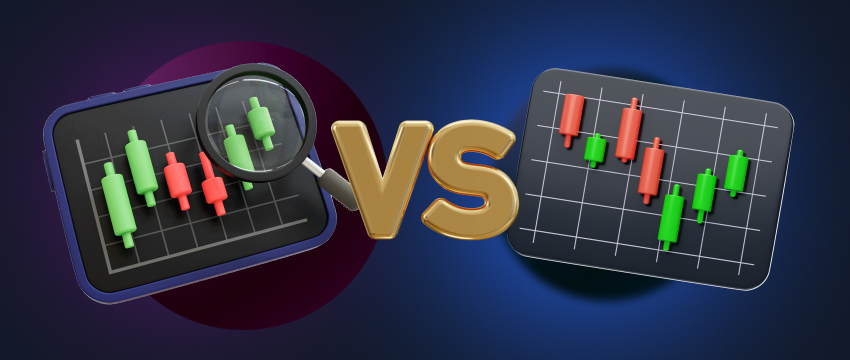Trading in financial markets has become increasingly popular, largely due to ease of access. Another reason the taste for trading is on the rise is the level of flexibility it provides. And by flexibility, we mean the amount of time required to commit to executing trades or analyzing markets.
But the question does arise pretty often: how many hours should one dedicate to investing to increase the likelihood of success? Does it require round-the-clock dedication or a more balanced approach? In this article, we’ll explore the connection between trading hours and investing styles, and how one impacts the other.
Trading styles
There are many ways that one can invest. This is based primarily on one’s objectives, budget, and risk tolerance. It’s also however dependent on the number of hours one has a day to commit to trading. All these factors combined typically dictate the style an investor will usually adopt. The four most prevalent styles are scalping, day trading, swing, and position trading. Let’s look at these a little more closely:
- Scalping: a scalper is a short-term investor who focuses on entering and exiting multiple investments in one trading day. They do this in an attempt to profit from small price movements frequently throughout the day. A scalper will commonly hold onto positions for a few seconds or minutes at best. They typically rely on technical analysis to make investing decisions.
- Day trading: a day trader also executes a large volume of investments in a day, but usually closes positions when the investing day concludes. Investors usually hold positions for seconds to hours before they sell them.
- Swing trading: unlike day traders or scalpers, a swing trader will hold onto positions for weeks or months. A lengthier investing approach, a swing investor may use a combination of technical and fundamental analysis to come to a financial decision. A swing trader commonly uses risk management tools to safeguard their money due to the length of time positions are held.
- Position trading: a position investor will usually manage trades that may even extend to years. A longer-term approach to investing relies on fundamental analysis for making strategic investment decisions. This type of investor will also analyze macroeconomic and market trends.

Choose a strategy based on investing hours
Each trading style comes with its own set of demands and time requirements. This in turn will impact the number of hours an investor will need to commit to executing investments.
Day investing and scalping
Day trading and scalping are probably the two most time intensive investing styles and require a significant number of hours to implement. These types of investors are usually very active during market hours. Depending on the market they are investing in, they may be actively engaged in executing investments for 6-8 hour stretches. Day traders and scalpers are usually glued to the screen throughout an investing session. They are constantly monitoring price movements, analysing market data and entering or exiting positions incredibly quickly. Traders usually exhibit behaviour characterised by discipline, focus, and swift decision-making skills.
Swing Trading
In contrast, swing trading offers a more balanced approach. This is because swing traders have more flexibility in terms of the time needed to undertake market analysis and execute trades. Since swing trading sees positions held for weeks or months, a trader can spend more hours analyzing and managing their positions. They are not as bound to a screen in the same way as day traders or scalpers due to the length of time that trades are held. This may however vary depending on market activity (high or low), frequency of trades, and the volatility of the markets being traded.
Position Trading
Position trading is undoubtedly the least demanding approach of the four. Traders focus on long-term trends and fundamental analysis. This means they don’t have to consult the markets as often as day traders, scalpers or position traders. A position investor is someone who can pursue a different occupation and engage in a position investing strategy on the side, or when time permits. It doesn’t require a daily amount of hours to commit to executing investments or market analysis. Saying that, it does need some period of fundamental analysis to ensure the markets are still aligned with anticipated trading outcomes.

Other steps to choosing a trading style
Picking an approach to trading requires some introspection and awareness of one’s goals, expertise, availability of time, and budget. There are key elements to consider and implement in the process of choosing your style.
Let’s take a look at them:
Investment Plan
Establish what you want to achieve and how quickly. Are you seeking fast gains or longer term profitable investing outcomes? Be definitive about your goals as these will serves as the basis of your trading plan.
Risks
Consider your risk tolerance and the amount of money you’re willing to lose in the course of trading. Don’t make use of money that has been set aside for more important life events, e.g., retirement, university, buying a house, health insurance. Choose a strategy that best aligns with your budget and level of risk you’re prepared to tackle.
Trading Style and Education Tools
Make sure that you have the expertise and skill necessary to implement the investment style you’ve chosen. Don’t go into it blindly. Study each approach by consuming online resources to ensure you have a proper understanding of what will be required of you. Make use of blogs, articles, e-guides, videos, and podcasts, take your pick, find your preferred method of learning, and wident your scope of knowledge.
T4Trade for instance is a powerful broker that provides its traders with free access to a wide range of insights, tips, and trading fundamentals via its T4Trade Academy. These educational tools are designed to help you make more informed decisions going forward.
Demo account
Consider signing up for a demo account to test out the various trading styles. A demo account will provide you with a simulated real-life environment in which you can put each style into practice, identify any strengths or weaknesses, and gauge outcomes. Using virtual funds, you will be able to execute trades without the fear of losing your own money. In this way, you can build the confidence required to move to a live trading environment. A demo account will also enable you to gain practical experience in technical and fundamental analysis so that you can make more informed decisions.
Trading Goals
Once you’ve determined your goals and acquired sufficient trade-related knowledge and practice, build a plan that aligns with both. Further, ensure that it incorporates risk management tools to limit losses and protect your capital.

In conclusion
Ultimately, there’s no one correct answer to how many hours one should trade in a day. It ultimately boils down to what you’re seeking to achieve, the style that bests suits you, and your lifestyle.
More importantly, it’s important to realize that regardless of how many hours one devotes to trading, your potential for success lies with other factors too, like ongoing learning, emotional resilience, market analysis, discipline, skill, and focus.
It’s also largely dependent on adopting effective risk management techniques to limit losses and attain your goals. Some of the most popular include stop-loss and take-profit orders, diversification, and position sizing. Being mindful of leverage is also very important, especially in regards to its ability to magnify losses exponentially.
Disclaimer: This material is for general informational and educational purposes only and should not be considered investment advice or an investment recommendation. T4Trade is not responsible for any data provided by third parties referenced or hyperlinked in this communication.




